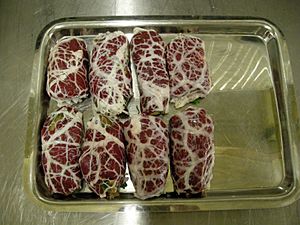Crépinette facts for kids
A crépinette is a special kind of small, flat sausage. It looks a bit like a round, flat patty. Instead of a regular sausage skin, it's wrapped in something called caul fat. This is a thin, lacy membrane from an animal. Crépinettes are often made from finely chopped (minced) meats like pork, turkey, veal, lamb, or chicken. Sometimes, they can even be made with fancy truffles! People usually cook them with a crispy bread coating and fry them in butter.
Contents
What's in a Name?
The word "crépinette" comes from French. It's related to the word crépine, which means "pig's caul" – that thin, lacy wrapping. The name first appeared way back in the 1200s! It was linked to the word crêpe, meaning a small, decorative crêpe.
Sometimes, in cookbooks, "crépinette" might just mean the meat inside, not the whole dish. But usually, it means both the filling and the finished, wrapped food.
What is a Crépinette?
A crépinette is basically a mix of finely chopped meat wrapped in a thin, natural membrane. Even though it doesn't have a typical sausage casing, it's often called a type of sausage dish. Many French dictionaries describe it as a round and flat food. What makes a crépinette special is that it's a ball of meat wrapped in these very thin layers of caul fat.
What's Inside a Crépinette?
The filling for a crépinette can be many different things! It's often made from ground pork or chicken fillets. Sometimes, people use finely ground meat from game birds like partridge, woodcock, or pigeon. You might also find lamb sweetbreads (a type of organ meat), calf kidneys, or even fillets of lark or rabbit inside. Some old recipes even show crépinettes made with whole pieces of meat, not just ground meat.
How to Cook Crépinettes
Crépinettes are usually cooked in a pan or on a grill until they are golden brown and cooked through.
In some parts of France, especially around Christmas, crépinettes are served in a unique way. In the Marennes-Oléron area, oyster farmers serve them with fresh oysters! It's a tradition in places like Bordelais too, where people enjoy alternating between a fresh, cool oyster and a warm, tasty crépinette.


